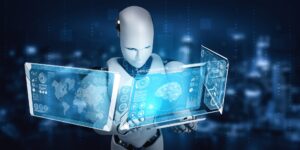In an era where technology evolves at an unprecedented pace, concerns about automation displacing human workers have become increasingly prevalent, especially after recent studies offered by the World Economic Forum that by 2025, over half of all workplace tasks will be performed by machines.
But AI is not about replacing human labor—it’s about augmenting it, specifically in how AI extends physical work. Picture a construction site where workers are equipped with AI-powered sensors, enhancing strength and mobility while reducing their risk of injury, a factory floor where robots work alongside human operators, autonomously performing repetitive tasks while humans focus on higher-level decision-making and creativity or a healthcare setting where AI algorithms analyze patient data to predict and prevent adverse health outcomes, enabling healthcare professionals to deliver more personalized and effective care.
These scenarios are not just figments of imagination; they represent tangible examples of how AI is revolutionizing physical jobs across industries through leveraging advanced algorithms, machine learning, and robotics, to empower workers in various businesses to perform their jobs more safely, efficiently, and effectively than ever before. From manufacturing and construction to healthcare and agriculture, the possibilities are endless, and the benefits are profound.
But the impact of AI goes beyond mere technological innovation; it’s as we said about human empowerment and resilience in the face of change, more specific it is about equipping workers with the tools and skills they need to thrive in an increasingly complex and dynamic world and ensuring that no one is left behind as we navigate the uncertain terrain of the Fourth Industrial Revolution.
In this article, we’ll explore the transformative potential of AI in prolonging physical careers, examining real-world examples, statistics, and case studies that highlight the tangible benefits for both workers and businesses.
From enhancing safety and productivity to fostering job satisfaction and well-being, AI is not just a tool—it’s a catalyst for positive change.
Enhancing Safety and Efficiency
AI-powered technologies are revolutionizing workplace safety by identifying and mitigating potential hazards. For instance, according to the Occupational Safety and Health Administration (OSHA), AI-enabled predictive analytics can help prevent up to 80% of workplace accidents by identifying high-risk areas and alerting workers in real-time. Moreover, AI-driven robotics are streamlining operations and reducing manual labor in industries like manufacturing and construction, leading to significant gains in efficiency and productivity.
Empowering Aging Workforce
As the global population ages, the workforce is undergoing a profound demographic shift. According to the U.S. Census Bureau, by 2030, all baby boomers will be older than 65, marking a significant milestone in workforce dynamics. However, with the right support and technology, older workers can continue to contribute meaningfully to the workforce. AI-enabled assistive technologies, such as smart wearables and AI-driven ergonomic tools, are enabling older workers to perform physically demanding tasks with greater ease and comfort, extending their careers and preserving invaluable expertise within organizations.
Fostering Collaboration and Innovation
AI is not just about automation; it’s about augmenting human capabilities and fostering collaboration between humans and machines. Research from Deloitte Insights reveals that companies that embrace AI-driven collaboration tools experience a 20% increase in employee productivity and a 30% reduction in time spent on manual tasks. By harnessing the power of AI to automate repetitive tasks and provide data-driven insights, workers can focus on higher-level decision-making, creativity, and innovation, driving continuous improvement and growth within organizations.
Promoting Inclusivity and Accessibility
AI has the potential to break down barriers and create more inclusive work environments for individuals with disabilities. According to the World Health Organization (WHO), over 1 billion people worldwide live with some form of disability, and ensuring equal access to employment opportunities is crucial for promoting social inclusion and economic empowerment. AI-powered assistive technologies, such as speech recognition software and adaptive learning platforms, are leveling the playing field and enabling individuals with disabilities to participate fully in the workforce, unlocking their potential and enriching the diversity of talent within organizations.
Driving Continuous Learning and Development
In today’s rapidly evolving work environment, continuous learning and development are essential for staying competitive and adaptable. AI-powered learning platforms leverage machine learning algorithms to personalize learning experiences and provide targeted recommendations for skill development. According to a survey by LinkedIn, 94% of employees would stay at a company longer if it invested in their career development. By embracing AI-driven learning solutions, businesses can empower employees to acquire new skills, stay engaged, and remain competitive in their fields, driving long-term career growth and organizational success.
Optimizing Resource Allocation
AI-driven analytics and forecasting tools enable businesses to optimize resource allocation and make data-driven decisions. By analyzing vast amounts of data in real-time, AI algorithms can identify trends, patterns, and opportunities that may go unnoticed by human analysts. For example, in healthcare, AI-powered predictive analytics can optimize staff scheduling and resource allocation based on patient demand and acuity levels, leading to improved patient outcomes and operational efficiency. Similarly, in retail, AI-driven demand forecasting tools can help businesses anticipate customer preferences and optimize inventory management, reducing stockouts and excess inventory costs. By leveraging AI to optimize resource allocation, businesses can improve efficiency, reduce costs, and drive sustainable growth.
To summarize, AI is not a threat to physical jobs; it’s a catalyst for positive change and innovation. By leveraging AI-powered technologies, businesses can enhance safety, efficiency, and collaboration in the workplace, empowering workers to thrive in an increasingly digital and interconnected world. From reducing workplace injuries to fostering inclusivity and accessibility, the transformative impact of AI on physical occupations is profound and far-reaching. So, as we embrace the possibilities of AI, let’s remember that its true power lies in its ability to augment human capabilities and create a more inclusive, equitable, and sustainable future of work for all.





